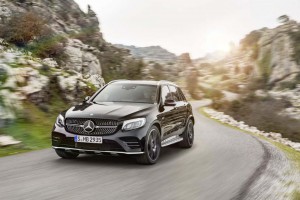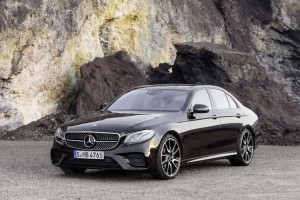
The Mercedes-AMG GLC 43 is powered by a twin-turbo V-6. AMG is looking to change the perception of what's considered "high performance."
It wasn’t all that long ago that delivering 300 horsepower was considered impressive and 400 almost unattainable. As performance fans know, a number of models have lately smashed through the 1,000 hp barrier, the new Bugatti Chiron punching the number up to 1,500.
But is horsepower alone the goal? Is that the only way to define performance? And if so, how far can the industry go?
While no slouch, with plenty of products topping the 600 horsepower, Daimler AG’s AMG arm wants to define what performance means on its own terms, and simply chasing ever-bigger numbers is not what that’s all about, said the German subsidiary’s CEO Tobias Moers, during a small media roundtable at the 2016 New York International Auto Show.
“It’s not necessary to only identify a performance brand by its power output,” stressed Moers. AMG, he insisted is focusing on what some might call a more holistic approach that puts equal value on driving dynamics, things like cornering and throttle response.
The recent decision to make all-wheel-drive standard on virtually all AMG models “brings it to next level,” he added.
At this year’s New York show, Mercedes-AMG is launching an assortment of performance models, and it’s redefining itself in the process. Until recently, the subsidiary focused on only the most exclusive Mercedes models, and fitted them with large V-8 and V-12 powertrains today pushing over the 600 hp mark.
(Mercedes expands C-Class line-up with new AMG C63 Cabrio. For more, Click Here.)
As products like the C43 and GLC43 demonstrate, AMG is broadening its reach. Both rely on twin-turbo V-6s making in the mid to high-300-hp range. They’re not quite as lavishly equipped either. But while they carry a sizable premium over mainstream Mercedes-Benz models, they’re far more affordable than classic AMG offerings.
That fills a yawning gap for something higher in performance but more affordable than those big V-8 and V-12 models, said Moers, noting that opened up “the opportunity to get new customers into the brand.” And, eventually, they may yet move up to the more extreme AMG lines.
That was nonetheless a controversial move, and linked to a broader discussion of AMG’s long-term strategy, the executive said.
“It is up to us to define the future of performance” Moers said, something all the more the case in an era when regulatory requirements are putting far more restrictions on what automakers can do. “It is up to us to find technologies and solutions.”
Powertrain downsizing has been one major solution, along with the addition of more advanced – and far more efficient – transmissions. But these may take the maker only so far as demands for lower emissions and better mileage continue.
(Click Here for details about the Mercedes GLC getting the AMG treatment.)
A number of manufacturers have begun turning to alternatives like hybrids, plug-ins and even pure battery-electric propulsion to meet the challenge. Porsche, for example, recently approved production plans for the Mission E battery sports car.
For AMG, hybrids and other battery-based models are all but certain to come, though Moers cautioned that this won’t happen until “2020 and beyond.”
But some forms of power are simply out of the picture. Asked whether AMG might do a diesel model, Moers didn’t miss a beat before firmly declaring, “No. Absolutely no.”
AMG sales have grown even faster than its line-up in recent years, a trend the subsidiary and parent expect to continue. In fact, “AMG could become a rival of Porsche,” Moers suggested, loosely quoting a recent comment by Daimler AG CEO Dieter Zetsche.
Admitting that is a “pretty ambitious” target, Moers noted AMG actually has outsold its rival in a few small markets like South Africa. Whether it can do so in places like Europe or the U.S. is another matter, he admitted. But it won’t be lack of trying. Daimler is investing heavily in AMG, and the performance unit is rapidly ramping things up, doubling its engineering capacity over the last five years, for example.
(Uber reportedly ordered 100,000 S-Class sedans from Mercedes. For more, Click Here.)
Whether AMG can redefine performance in its own image is not yet certain, but it won’t be for lack of trying.

